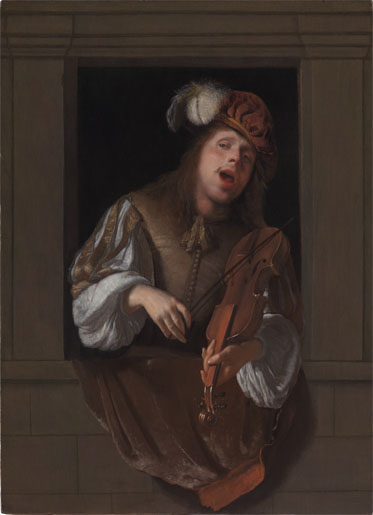Dressed in the fanciful costume of a performer, this alluring musician sings to the tune of his violin while leaning out of an open window. His festive attire harks back to early sixteenth-century styles, including the dark red velvet beret with plumed feathers, the luxurious satin brown shirt with slashed ribbons, and the aubergine-colored velvet jacket slung casually over the window sill. With heartfelt engagement in his music, the young man peers at his audience from the corners of his eyes. One can almost hear the tenor of his voice as it harmonizes with the notes of the violin and imagine the music rising in crescendo before falling away into silence.
This captivating image, which was first published as an autograph work by Jacob Ochtervelt in 1979, relates closely to a group of other half-length figures that the artist executed between 1665 and 1675.1 Ochtervelt appears to have based one of these paintings, Singing Violinist, 1666, in the Glasgow Art Gallery and Museum (fig 1), on a work by the Leiden artist Pieter van Noort (1622/25–72) (fig 2).2 Van Noort’s Hearing from ca. 1635 is from a series devoted to the five senses, suggesting that Ochtervelt’s painting in Glasgow, and by extension this work from The Leiden Collection, may also have been conceived as Hearing in a now-lost series of the five senses.3 Susan Donahue Kuretsky has identified these two depictions of a violinist, as well as a third example, as self-portraits.4
More than one third of Ochtervelt’s oeuvre is devoted to musical subjects, perhaps because, as Kuretsky suggests, he was a musician himself.5 The majority of these paintings depict interiors with full-length figures absorbed in flirting, feasting, and playing music; all include precise representations of instruments and an informed knowledge of how they were played. In the Leiden Collection painting, Ochtervelt portrays himself at ease, holding the instrument against his shoulder in accordance with how seventeenth-century violins were played.6 At the end of the violin’s neck, the frayed ends of the strings hang in ringlets near the pegs. In all three of his self-portraits with a violin, Ochtervelt portrays his left hand fingering the same chord, as though he were representing a specific moment of a favorite song.
Ochtervelt executed two other paintings from this period in which half-length figures appear in a window: Singing Woman, formerly on the art market in Vienna (fig 3), and its presumed pendant, Man in a Niche, dated 1668, in the Städelsches Kunstinstitut in Frankfurt (fig 4).7 Because of the similar size and corresponding musical subject matter of the Singing Woman with The Leiden Collection’s Self-Portrait, Otto Naumann suggested that they may have been conceived as pendants.8 The similarity of the architectural niche in these two paintings, however, is somewhat misleading, since the present painting has been largely reconstructed. During conservation treatment in 2008 it became evident that the window element had suffered from abrasion and that an earlier restorer had imaginatively overpainted the architecture with an arched window (fig 5). When this overpaint was entirely removed, it became clear that the niche was a originally configured as a rectangle (fig 6). The conservator therefore reconstructed the architectural details using the Vienna and Frankfurt paintings as models, which is how the painting is seen today.9 The idea that Singing Violinist and Singing Woman were originally pendants is difficult to confirm, though possible. The suggestion that the Singing Violinist may have been part of a pair, rather than one of series depicting the five senses, is also compelling.
Regardless, the artist’s treatment of the present Singing Violinist demonstrates a deeper impact of the Leiden painting beyond the influence of Van Noort’s example. Ochtervelt’s meticulous rendition of details and emulation of the interplay of light on different surfaces, including the soft texture of his silk sleeves, flouncy quality of the feathers, and plushness of the velvet, connect this painting to the fijnschilder tradition of Leiden artists such as Gerrit Dou (1613–75) and Frans van Mieris the Elder (1635–81).10 Not only has Ochtervelt adopted a small-scale format similar to that of his Leiden counterparts, but his use of a window derives from a motif that appears frequently in Dou’s works. An exquisite painting by Dou from 1653, Violin Player, now in the Princely Collections at Vaduz Castle, Liechtenstein (fig 7), represents the type of painting—in scale, subject matter, and composition—that inspired Ochtervelt.11
